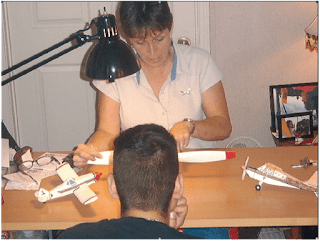Carol, a flight instructor, has planned the first tailwheel flight with Jacob, her learner pilot. She begins the preflight briefing with an explanation of the tendency of tailwheel aircraft to yaw in normal takeoff. This yawing tendency gives the illusion that the tailwheel aircraft is unstable during the takeoff. Since this yawing tendency occurs on every takeoff, it is predictable and the pilot is able to compensate for it. Carol then discusses the precession, which causes the noticeable yaw when the tail is raised from a three-point attitude to a level flight attitude. This change of attitude tilts the horizontal axis of the propeller, and the resulting precession produces a forward force on the right side (90° ahead in the direction of rotation), yawing the aircraft’s nose to the left. To demonstrate the yawing tendency, she places a model aircraft prop under a desk lamp. [Figure] By moving the prop, the shadow it casts illustrates the pitch change of the propeller when the aircraft is on its tailwheel and when the aircraft is raised to a level flight attitude.
 |
| An aviation instructor communicates with her learner using model airplanes to ensure the learner’s understanding of the principles discussed |
Effective communication is an essential element of instruction. An aviation instructor may possess a high level of technical knowledge, but he or she needs to cultivate the ability to communicate effectively in order to share this knowledge with learners. Although communication is a complex process, aviation instructors need to develop a comfortable style of communication that meets the goal of passing on desired information to learners.
Communicating effectively is based on similarity of the idea transmitted by the source and received by the receiver. Similarly, as the source, instructors have communicated effectively if the learner has understood the idea/concept/action transmitted in the manner in which it was intended to be understood.
It is also important to recognize that communication is a two-way process. Each instructor and learner may have a unique communication style, and bridging the gap between these styles is an important aspect of providing instruction. The elements of effective communication, the barriers to communication, and the development of communication skills are discussed in this site.
